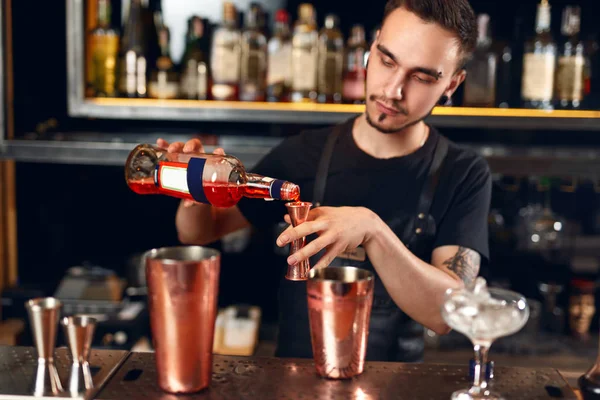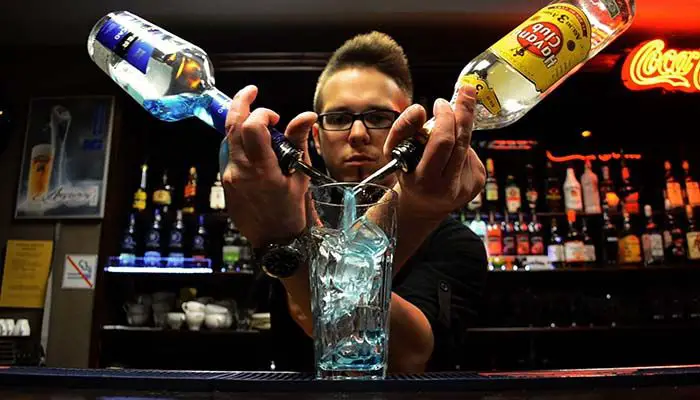So you’re curious to learn what your bartenders talk about, or are you interested in nailing your bartending interview? You only wish to get better at bartending and learn more about it.
Bartender talk is more straightforward than one may think. Find some note cards and learn these must-know phrases and keywords for bartending! But don’t use it as a way to get others to drink.
Table of Contents
ToggleMost Common Bartending Terms

There are specific phrases and words that bartenders and servers use that you have heard at least once.
- Deep: 2-deep, 3-deep, for example, implies that two or three people are in line at the bar.
- 86’d: This is bar slag for running out of something or stopping a particular thing.
- Free Pour: Preparing and mixing beverages without employing a measuring tool.
- Liquor: Liquor is just another term for alcoholic drinks. Therefore, it’s liquor if it contains alcohol.
- Angel’s Share: This concerns how much alcohol disappears when the alcohol ages.
- Back: A “back” is a tiny glass of anything with a drink. It might be water or cola.
- Autograt: Gratuity that is included in a group’s bill swiftly, typically due to the size of the group.
- Behind The Stick: To put it plainly, work behind the bar.
- Bar Spoon: A spoon with a long handle that mixes and lays beverages. Its length ensures it gets to the bottom of a long tumbler or jug to combine things within the glass.
- Proof: The term appears on every bottle label and specific drink list. If you split the proof number by two, you get the amount of booze in the liquor. For instance, 100-proof booze has 50% booze.
- Aperitif: A low-alcohol drink that’s generally taken before eating something to make your appetite.
- Build: Use an electric blender to combine items and ice. These can be named frozen or mixed drinks, based on your place.
- Bartender’s Handshake: Typically a shot and free of charge, this is an offer from one bartender to another.
- Burn The Ice: The ice has to melt! It may be since someone broke a glass or dropped something in the ice well, in which instance somebody will spray a red “X” on the ice with grenadine, or it may be the end of the night and the ice has been melting with warm water.
- Bruised: While a drink or martini is shaken excessively and bubbles of oxygen and ice form. It makes the glass look cloudy or murky.
- Shot: A shot is an amount of measurement for alcohol. It’s equivalent to 1.5 oz. Double, triple, or multiply it as you deem proper.
Terms Bartenders Use When Serving A Drink

Popular bar terms you need help understanding make you look like a beginner. Using an incorrect word for a drink may entirely alter how it tastes and how it’s prepared. So that you don’t seem like a newbie, we’ve compiled a list of the most frequently confused bar terms.
“Straight Up,” “Up, “and” Neat” are all popular ways of serving a drink, and customers often get the terms mixed up when they order. Usually, it has to be made more evident. We’ve laid out the meanings below to show how they’re different.
- Straight Up: This describes a drink shaken using a shaker and strained into a glass.
- Up: A given drink is shaken or stirred to cool it down, then it is strained into a cooled cocktail glass without ice.
- Neat: This shot comes fresh from the bottle, with no added ice or extra ingredients.
All three ways make a drink without ice, yet a neat drink gets room temperature, a straight-up drink is cooled by shaking or stirring with ice, while an up drink gets cool with a chilled glass. Ice is vital for freezing a drink without diluting it.
A drink on the rocks is ideal with clear, slow-melting ice and a singular spirit. Yet, asking for a frosted beer will give you a glass soaked in water and frozen—finally, a misty cocktail with smashed ice.
- Frost: A beer glass dipped in water, rinsed, and finally placed in the freezer.
- Mist: Liquor poured in crushed ice in a glass.
- On The Rocks: Most of the time, these drinks come with ice.
A popular way to create a beverage is to shake or stir it. Being served both ways may alter how the beverage tastes; knowing what each term means is vital as it influences how a drink looks and tastes.
- Stirred: A gentler form to create a cocktail, typically with distilled spirits or light mixers. It’s the best way to make delicate drinks like Manhattans.
- Shaken: A way to create a drink. The ingredients are put into a shaker, shaken, and then emptied into a glass. It is often used for beverages like martinis and cocktails with thick mixers or diaries.
Bartending Terms When Garnishing A Drink

- Splash: Less than a quarter ounce makes a splash. A splash of something is intended to improve the taste, not take over.
- Bitters: A mixture of herbs and booze that’s made to be put into additional drinks to make them taste better. Angostura Bitters is one of the more famous brands. It was first created in 1824 by a German physician to treat stomach problems.
- Muddled: This means using a muddler to grind and crush various substances. Most drinks, like the Mojito, are created this way.
- Sours: The phrase “sour” means the sourness of bar lime mix, lime bar mix, margarita mix, or sour bar mix, which are used in numerous drinks. When somebody gets a Vodka Sour, they desire bar lime mix and vodka.
Conclusion
Even if you only understand just a couple of these words, you’ll gain a greater understanding of what’s going on around you at the bar. With additional insight, you could climb from the ground floor to behind the bar.
With these terms in your control, you’re ready to become the next best bartender of this age. As you notice, numerous bartending words are simple to recall since they are easy to grasp.
Regardless of why you’re eager to learn more bartending terms, you’re already on your journey to looking like an expert.

I am a passionate beer connoisseur with a deep appreciation for the art and science of brewing. With years of experience tasting and evaluating various beers, I love to share my opinions and insights with others and I am always eager to engage in lively discussions about my favorite beverage.
















